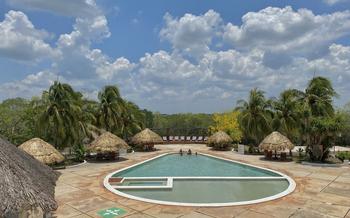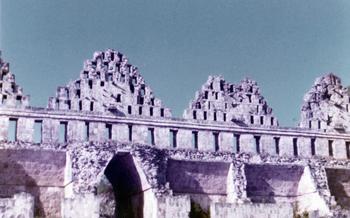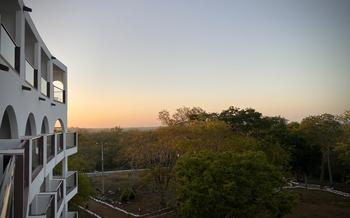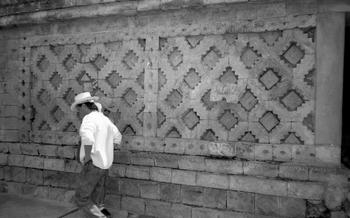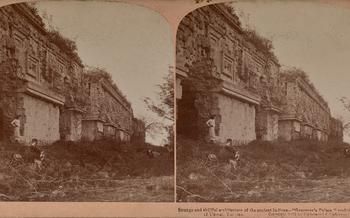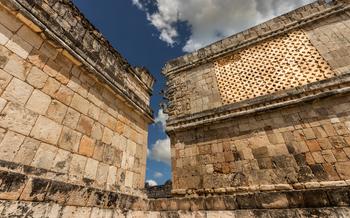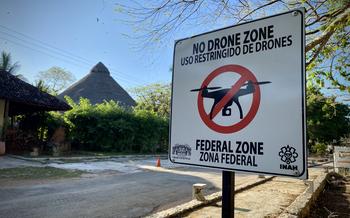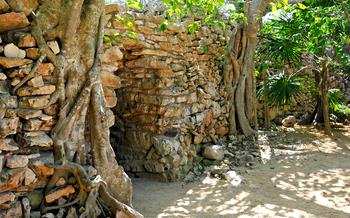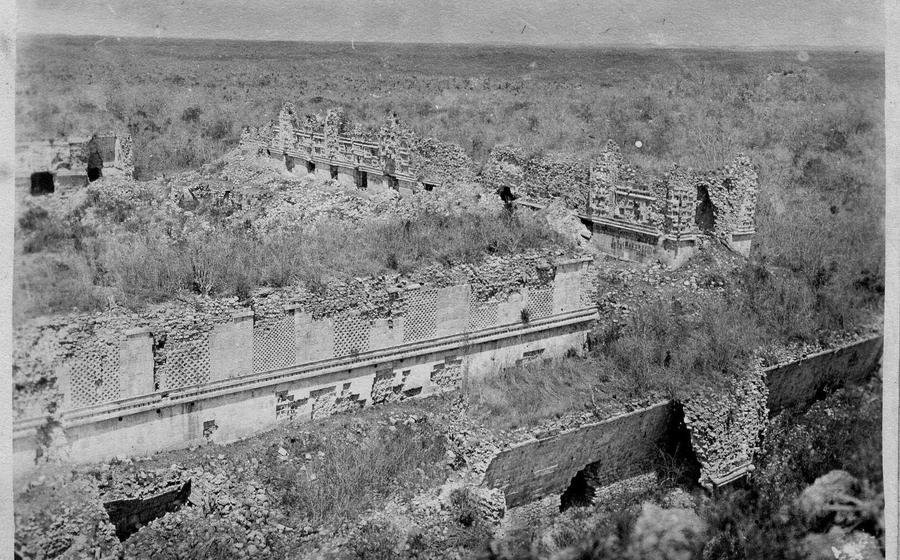
Nunnery Quadrangle
- Uxmal: A Majestic Mayan City in the Yucatan Peninsula
- Unveiling the Nunnery Quadrangle: A Place of Sacred Rituals
- Exploring the Nunnery Quadrangle: A Journey Through History
- The Great Pyramid: A Monumental Structure Within the Quadrangle
- The Palace of the Governor: A Masterpiece of Mayan Architecture
- The House of the Turtles: A Unique Structure with Animal Symbolism
- The Ball Court: A Place for Ritual Games and Competition
- The Temple of the Old Woman: A Mysterious Structure with Unrevealed Secrets
- The East Building: A Complex of Structures with Diverse Functions
- The West Building: A Residential Complex with Unique Features
- The South Building: A Place of Rituals and Ceremonies
- The North Building: A Complex with Diverse Functions
- The Nunnery Quadrangle at Night: A Magical Experience Under the Stars
- Insider Tip: Exploring Beyond the Nunnery Quadrangle
Uxmal: A Majestic Mayan City in the Yucatan Peninsula
Uxmal, a majestic ancient city, stands as a testament to the ingenuity and cultural achievements of the Maya civilization. Located in the heart of the Yucatan Peninsula in Mexico, this awe-inspiring metropolis flourished during the Late Classic period from 700 to 1000 AD. With its well-preserved architecture, intricate carvings, and captivating history, Uxmal invites visitors to step back in time and immerse themselves in the grandeur of the Maya world.
Reached by well-maintained roads, Uxmal boasts a distinctive architectural style characterized by intricate stone mosaics, corbelled arches, and elaborate sculptures. The city's awe-inspiring structures showcase the Maya's mastery of engineering and their deep connection to the natural world. Uxmal's cultural and religious significance is evident in its numerous temples, palaces, and ball courts, which served as centers of political, spiritual, and social life for the ancient Maya.
Unveiling the Nunnery Quadrangle: A Place of Sacred Rituals
In the heart of the ancient Mayan city of Uxmal, lies a sacred precinct known as the Nunnery Quadrangle. This architectural masterpiece, located on the western side of the site, is a testament to the religious and cultural significance of the Maya civilization. The quadrangle derives its name from the Spanish conquistadors who, upon encountering the complex, mistook it for a convent due to its resemblance to European monasteries.
The Nunnery Quadrangle is a marvel of Mayan architecture, showcasing intricate carvings, sculptures, and decorative motifs that narrate the stories of the Maya gods, rulers, and their beliefs. The complex consists of four long buildings arranged around a central courtyard, each serving a distinct purpose in the religious and ceremonial life of the Maya. The buildings are adorned with elaborate friezes depicting scenes of everyday life, mythological tales, and historical events, providing a glimpse into the rich cultural heritage of the Maya.
The quadrangle's main entrance is marked by a grand archway, which leads visitors into the courtyard. The courtyard is surrounded by a series of rooms and chambers, each with its own unique features and significance. Some of these rooms were used for religious rituals, while others served as living quarters for the priests and other religious officials. The quadrangle was a sacred space where the Maya performed various ceremonies, including those related to fertility, rain, and the maize harvest.
The Nunnery Quadrangle holds immense historical and cultural significance, as it represents the spiritual and religious center of Uxmal. It is a testament to the Maya's deep connection to their gods and their belief in the supernatural. Visitors to the Nunnery Quadrangle can immerse themselves in the mysticism of the ancient Maya, gaining a deeper understanding of their religious practices and the profound impact they had on the development of Mayan civilization.
Exploring the Nunnery Quadrangle: A Journey Through History
Strolling through the Nunnery Quadrangle, one can't help but be captivated by its intricate carvings and sculptures that adorn every corner. Each stone tells a story, each design holds a hidden meaning, inviting visitors on a journey through time. The rooms and chambers, once bustling with activity, now stand silent, yet their purpose lingers in the air. One can almost imagine the ancient Maya performing their sacred rituals, their voices echoing through the courtyards, their footsteps leaving an imprint on the worn stone floors.
Here, visitors can explore the East Building, a complex of structures that once served various functions. The West Building, with its residential units, offers a glimpse into the daily lives of the Maya who called this place home. The South Building, dedicated to rituals and ceremonies, exudes an aura of spirituality, while the North Building, with its diverse chambers, hints at the many activities that took place within its walls.
As you wander through the Nunnery Quadrangle, let your imagination soar. Picture the Maya people going about their daily lives, tending to their crops, performing their rituals, and celebrating their triumphs. Feel the energy of their presence as if they were still there, guiding you on this historical journey.
The Great Pyramid: A Monumental Structure Within the Quadrangle
At the heart of the Nunnery Quadrangle lies the Great Pyramid, a colossal structure that dominates the skyline and evokes awe in visitors. Towering over the other buildings, this pyramid is a testament to the architectural prowess and religious devotion of the ancient Maya.
With a height of approximately 30 meters, the Great Pyramid is the tallest structure within the quadrangle. Its massive base spreads out over a vast area, creating a sense of grandeur and imposing presence. The pyramid's exterior is adorned with intricate carvings and sculptures, depicting mythological scenes, deities, and historical events.
The Great Pyramid served as a sacred temple and a place of religious ceremonies. It was dedicated to the Maya rain god, Chaac, who was believed to control the life-giving rains essential for agriculture and sustenance. Inside the pyramid, there are several chambers and passageways, some of which were used for rituals, offerings, and burials.
The pyramid's symbolism and significance in Mayan culture are profound. It represented a connection between the earthly and spiritual realms, a bridge between the Maya people and their deities. The pyramid's height and grandeur symbolized the power and majesty of the gods, while its intricate carvings narrated the stories of their mythology and history.
The Palace of the Governor: A Masterpiece of Mayan Architecture
In close proximity to the Nunnery Quadrangle, the Palace of the Governor stands as a testament to the architectural prowess of the ancient Maya. Its imposing presence commands attention with its intricate design and imposing size. The palace served as the residence and administrative center for Uxmal's rulers, who governed and conducted important affairs of state within its walls.
The Palace of the Governor showcases a remarkable blend of elegance and functionality. Its facade is adorned with intricate carvings depicting various deities, mythical creatures, and scenes from Mayan life. These carvings provide a glimpse into the cultural and religious beliefs of the ancient Maya, offering a deeper understanding of their rich heritage.
Inside the palace, a series of interconnected rooms and chambers unfolds, each serving a specific purpose. Some rooms were used for official meetings and ceremonies, while others served as living quarters for the royal family and their entourage. The palace's strategic location allowed the rulers to oversee the city's activities and maintain control over the surrounding territories.
As a symbol of power and authority, the Palace of the Governor played a pivotal role in the political and social hierarchy of Uxmal. It stands as a testament to the ingenuity and organizational skills of the ancient Maya, who built this magnificent structure without the use of modern tools or machinery.
The House of the Turtles: A Unique Structure with Animal Symbolism
Within the Nunnery Quadrangle, one of the most intriguing structures is the House of the Turtles. This unique building stands out with its distinctive features and turtle motifs that adorn its façade. The turtles, carved in intricate detail, have symbolic meaning in Mayan culture, representing water and fertility.
The House of the Turtles is believed to have been a residence or a ceremonial building, possibly used for rituals related to water and agriculture. Its association with water is further emphasized by the presence of a cenote, or natural well, located nearby.
Visitors can admire the intricate carvings depicting turtles on the building's exterior, as well as explore the interior chambers to learn more about its historical and cultural significance. The House of the Turtles offers a glimpse into the beliefs and practices of the ancient Maya, and its unique symbolism makes it a must-see attraction within the Nunnery Quadrangle.
The Ball Court: A Place for Ritual Games and Competition
Within the Nunnery Quadrangle lies a significant structure known as the Ball Court, a testament to the ancient Maya's love for sports and rituals. This impressive court is distinguished by its elongated shape, with two parallel walls featuring stone rings fixed high on each side. These rings, strategically placed, served as goals during the sacred ball game, a deeply symbolic and ritualistic sport that held great cultural and religious importance in Mayan society.
The rules of the ball game were intricate and governed by strict traditions. Players used their hips, elbows, and sometimes their head to propel a solid rubber ball towards the stone rings. The objective was to pass the ball through the rings, a feat that required immense skill, agility, and teamwork. The game was not merely a sport; it was a sacred ritual believed to have deep cosmological and religious significance.
The ball court was not just a place for competition; it was also a stage for elaborate ceremonies and rituals. The Maya believed that the ball game represented the cosmic struggle between day and night, light and darkness, and the cycles of life and death. The outcome of the game was seen as an omen, with victory or defeat having implications for the well-being of the community and the success of their agricultural endeavors.
The Temple of the Old Woman: A Mysterious Structure with Unrevealed Secrets
In the enigmatic realm of the Nunnery Quadrangle, the Temple of the Old Woman stands as a silent guardian of secrets yet to be unraveled. Its presence evokes a sense of mystery and intrigue, captivating the imaginations of visitors who seek to decipher its hidden meanings.
The temple's architectural features exude an air of antiquity, hinting at a rich history that remains shrouded in obscurity. Its design elements, characterized by intricate carvings and symbolic motifs, provide glimpses into the minds of the ancient Maya who constructed it.
Scholars and archaeologists have proposed various theories regarding the purpose and significance of this enigmatic structure. Some believe it served as a place of worship dedicated to a specific deity, while others suggest it was used for astronomical observations or as a burial chamber for high-ranking individuals.
Despite the ongoing debate surrounding its exact function, the Temple of the Old Woman remains a captivating monument that invites visitors to ponder the mysteries of the past. Its allure lies in the untold stories it holds, waiting to be discovered by those who seek to delve deeper into the enigmatic world of the ancient Maya.
The East Building: A Complex of Structures with Diverse Functions
Located to the east of the Nunnery Quadrangle, the East Building stands as a testament to the diverse and complex nature of Mayan architecture. A sprawling complex of interconnected structures, it served a variety of purposes, catering to the religious, administrative, and residential needs of the ancient Maya.
The East Building's architectural design is characterized by a series of long, narrow chambers arranged around central courtyards. These chambers likely served as workshops, storage rooms, and living quarters for the Maya who resided within the Nunnery Quadrangle. The building's proximity to the quadrangle suggests that it played a crucial role in supporting the daily life and activities of the nuns and other religious figures who inhabited the complex.
The East Building's historical and cultural significance lies in its representation of the Maya's organizational and societal structure. The presence of various chambers and spaces within the building indicates that it was not solely dedicated to a single function but rather served as a multifunctional complex that met the diverse needs of the community.
Whether it was used for religious ceremonies, administrative tasks, or residential purposes, the East Building stands as a testament to the Maya's ingenuity and their ability to create complex and versatile architectural spaces that reflected their cultural and societal values.
The West Building: A Residential Complex with Unique Features
Located adjacent to the Nunnery Quadrangle, the West Building stands as a testament to the domestic life of the ancient Maya. Its well-preserved structures reveal a complex of residential units, each featuring multiple rooms arranged around a central courtyard. The rooms, varying in size and layout, likely served different purposes, from sleeping quarters to storage spaces.
The West Building exhibits distinct architectural features that set it apart from other structures in Uxmal. The facades showcase intricate stone carvings depicting various motifs, including human figures, animals, and geometric patterns. These carvings provide a glimpse into the artistic prowess and cultural symbolism of the Maya.
The historical and cultural significance of the West Building lies in its role as a residential complex. It offers insights into the daily lives and social organization of the ancient Maya. Archaeologists believe that the building may have housed families of high-ranking officials or artisans who played essential roles in the functioning of Uxmal's society.
Exploring the West Building allows visitors to imagine the daily routines and activities of the Maya who once called this place home. One can envision families gathering in the courtyards, children playing, and adults engaging in various domestic tasks. The building's well-preserved state offers a unique opportunity to connect with the past and gain a deeper understanding of Mayan culture.
The South Building: A Place of Rituals and Ceremonies
Located in close proximity to the Nunnery Quadrangle, the South Building stands as a testament to the religious and ceremonial significance of Uxmal. Its architectural features reflect a distinct purpose, with spacious chambers and open courtyards designed to accommodate large gatherings. The intricate carvings and sculptures adorning the building's facade depict various deities and mythological scenes, hinting at the sacred nature of the rituals performed within.
Historians believe that the South Building served as a central location for religious ceremonies, festivals, and public gatherings. The large plazas and courtyards provided ample space for people to congregate, participate in rituals, and witness important events. The building's proximity to the Nunnery Quadrangle suggests a close connection between the religious activities conducted by the priests and the daily lives of the inhabitants.
The South Building's design also incorporates elements that enhance its functionality for ceremonial purposes. Raised platforms and stepped altars are strategically positioned within the building, creating elevated spaces for religious leaders to conduct rituals and deliver speeches. Niches and recesses in the walls served as places to display sacred objects, offerings, and incense burners, further enhancing the spiritual atmosphere.
Exploring the South Building, visitors can imagine the vibrant energy and devotion that filled these spaces during ancient times. The building's architectural details, combined with historical accounts, offer a glimpse into the complex rituals and ceremonies that were an integral part of Mayan culture.
The North Building: A Complex with Diverse Functions
Located to the north of the Nunnery Quadrangle, the North Building is a complex structure that served various purposes in ancient Maya society. Its architectural design features multiple chambers and rooms, each with distinct characteristics and functions.
One of the notable features of the North Building is its intricate carvings and sculptures, which depict various scenes and figures from Mayan mythology and history. These intricate artworks provide valuable insights into the beliefs and cultural practices of the ancient Maya.
The historical significance of the North Building lies in its role as a multifunctional space. It is believed to have served as a residential area, where members of the elite Maya society resided. Additionally, it may have been used for administrative purposes, with some chambers possibly serving as offices or meeting rooms.
While the exact purpose of each chamber within the North Building remains a subject of ongoing research, it is clear that this structure played a significant role in the daily life and activities of the ancient Maya. Exploring the North Building offers visitors a glimpse into the diverse functions and complexities of this ancient civilization.
The Nunnery Quadrangle at Night: A Magical Experience Under the Stars
As the sun sets, the Nunnery Quadrangle transforms into a magical realm under the starry sky. The ancient structures are bathed in a soft, ethereal glow, creating an enchanting atmosphere that transports visitors back in time. Special effects and artistic lighting illuminate the intricate carvings and sculptures, highlighting their beauty and symbolism.
Cultural performances and storytelling sessions bring the history and legends of Uxmal to life. Visitors can immerse themselves in the tales of ancient Maya rituals, myths, and traditions, gaining a deeper understanding of the culture that created this remarkable city. The unique atmosphere and ambiance of the night-time Nunnery Quadrangle create a truly unforgettable experience.
To capture the best photos and memories, it's recommended to use a tripod and a wide-angle lens to capture the expansive views of the illuminated structures. Experiment with different shutter speeds and apertures to create dramatic effects and capture the essence of the night-time magic.
Insider Tip: Exploring Beyond the Nunnery Quadrangle
While the Nunnery Quadrangle is undoubtedly a highlight of Uxmal, there's so much more to explore within this ancient city. Beyond the quadrangle, visitors can marvel at the iconic Great Pyramid, a towering structure that dominates the skyline. Climb its steep steps to reach the temple at the summit and be rewarded with breathtaking views of the surrounding jungle.
Another must-see attraction is the House of the Magician, renowned for its intricate carvings and fascinating architectural features. Discover the secrets behind its name and learn about the theories surrounding its purpose and significance.
To fully immerse yourself in the Mayan world, consider exploring nearby sites such as Kabah, Sayil, and Labna. These lesser-known ruins offer a glimpse into the diverse architectural styles and traditions of the ancient Maya. Each site has its unique charm and characteristics, making them worthy additions to any Uxmal itinerary.
Enhance your experience by hiring a knowledgeable guide who can provide insights into the history, culture, and symbolism of Uxmal's structures. Their expertise will bring the ruins to life and help you understand the significance of what you're seeing.
Remember to allocate ample time to explore Uxmal and its surroundings. Allow yourself to wander, soak in the atmosphere, and appreciate the beauty of these ancient wonders. With so much to see and discover, Uxmal offers an unforgettable journey into the heart of the Mayan civilization.
